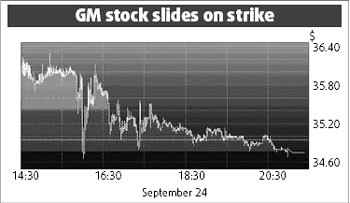Talks offer glimmer of hope in dispute
The United Auto Workers' return to bargaining with General Motors Corp within hours of calling the first national strike against the automaker in 37 years may signal the union's desire for a quick end to the walkout.
"It shows that the union leadership does in fact want to reach an agreement," said Jules Crystal, a labor lawyer at Bryan Cave LLP in Chicago, who has negotiated more than 260 contracts with the UAW and other unions for auto-parts suppliers. "In many cases, the union would walk out in a huff and say, 'Call us when you're ready to talk'."

Monday's 11 am (local time) strike followed almost 25 hours of continuous bargaining in Detroit. By early afternoon, bargainers returned to the table for a session that lasted until about 8 pm.
The showdown between GM and the UAW, while pivotal to the automaker's future profit and the union's dwindling membership, isn't expected to match the battles the two sides waged during the union's infancy in the 1930s. Neither side can afford a long strike that cuts GM profit or gives Toyota Motor Corp a chance to win more US buyers and force the closing of even more UAW plants.
"Toyota is probably just waiting to pounce, to take more market share," said Crystal, referring to Toyota's claim to 16.2 percent of the US market so far this year, from 9.3 percent in 2000. GM's share in that span fell to 23.6 percent from 28.1.
The dispute highlighted the conflicting goals of GM's Rick Wagoner, in his eighth year as chief executive officer, and the UAW's Ron Gettelfinger, in his second term as president.
Wagoner is using the negotiations to cut labor and health- care costs that contributed to $12.4 billion in losses in 2005 and 2006. Gettelfinger seeks to preserve pay, benefits and jobs, while US automakers GM, Ford Motor Co and Chrysler LLC shed sales and market share to Toyota and other Japanese rivals.
The expectations that the union established in the 1950s under President Walter Reuther - such as pensions, healthcare and regular wage increases - may need to be satisfied in different ways, said Paul Gerhart, a professor at Case Western Reserve University in Cleveland.
Reuther's legacy
"It's not really Reuther's underlying goals that are on the table; what's on the table is, 'How do you achieve them?'" Gerhart said. "Reuther himself said a contract is not a dead piece of paper; it's a living document."
Gettelfinger said on Monday the union supports the central idea of the talks, a plan to transfer an estimated $50 billion in future UAW retiree health-care costs to the union in exchange for a one-time payment from GM to set up a trust fund. Future healthcare payments would come from income earned off the investments.
The strike was about job security and other traditional issues, not the healthcare plan, he told reporters.
GM, in a statement on Monday, said it sought an agreement "as soon as possible".
The automaker's 8.375 percent bond due July 2033 climbed 1.75 cents to 89 cents on the dollar, the highest since July 19, according to Trace, the bond-price reporting system of the NASD. The yield fell to 9.53 percent.
Bloomberg News
(China Daily 09/26/2007 page16)














